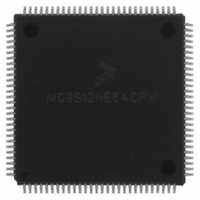MC9S12NE64CPV Freescale Semiconductor, MC9S12NE64CPV Datasheet - Page 375

MC9S12NE64CPV
Manufacturer Part Number
MC9S12NE64CPV
Description
IC MCU 25MHZ ETHERNT/PHY 112LQFP
Manufacturer
Freescale Semiconductor
Series
HCS12r
Datasheet
1.MC9S12NE64VTU.pdf
(554 pages)
Specifications of MC9S12NE64CPV
Mfg Application Notes
MC9S12NE64 Integrated Ethernet Controller Implementing an Ethernet Interface with the MC9S12NE64 Web Server Development with MC9S12NE64 and Open TCP
Core Processor
HCS12
Core Size
16-Bit
Speed
25MHz
Connectivity
EBI/EMI, Ethernet, I²C, SCI, SPI
Peripherals
POR, PWM, WDT
Number Of I /o
70
Program Memory Size
64KB (64K x 8)
Program Memory Type
FLASH
Ram Size
8K x 8
Voltage - Supply (vcc/vdd)
2.375 V ~ 3.465 V
Data Converters
A/D 8x10b
Oscillator Type
Internal
Operating Temperature
-40°C ~ 85°C
Package / Case
112-LQFP
Data Bus Width
16 bit
Data Ram Size
8 KB
Interface Type
I2C, SCI, SPI
Maximum Clock Frequency
25 MHz
Number Of Programmable I/os
70
Number Of Timers
16 bit
Operating Supply Voltage
- 0.3 V to + 3 V
Maximum Operating Temperature
+ 105 C
Mounting Style
SMD/SMT
Minimum Operating Temperature
- 65 C
On-chip Adc
10 bit
For Use With
EVB9S12NE64E - BOARD EVAL FOR 9S12NE64DEMO9S12NE64E - DEMO BOARD FOR 9S12NE64
Lead Free Status / RoHS Status
Contains lead / RoHS non-compliant
Eeprom Size
-
Lead Free Status / Rohs Status
No RoHS Version Available
Available stocks
Company
Part Number
Manufacturer
Quantity
Price
Company:
Part Number:
MC9S12NE64CPV
Manufacturer:
RENESAS
Quantity:
21 000
Company:
Part Number:
MC9S12NE64CPV
Manufacturer:
FREESCAL
Quantity:
455
Company:
Part Number:
MC9S12NE64CPV
Manufacturer:
Freescale Semiconductor
Quantity:
10 000
Company:
Part Number:
MC9S12NE64CPVE
Manufacturer:
ST
Quantity:
445
Company:
Part Number:
MC9S12NE64CPVE
Manufacturer:
Freescale Semiconductor
Quantity:
10 000
- Current page: 375 of 554
- Download datasheet (4Mb)
4B/5B Encoder/Decoder: The 4B/5B encoder converts the 4-bit nibbles from the reconciliation sublayer
to a 5-bit code group.
12.4.4.1.2
The PMA provides medium-independent means for the PCS and other bit-oriented clients (e.g., repeaters)
to support the use of a range of physical media. For 100BASE-TX the PMA performs these functions:
12.4.4.1.3
For 100BASE-TX, the ANSI X3.263: 199X (TP-PMD) standard is used. These signalling standards, called
PMD sublayers, define 125 Mbps, full-duplex signalling systems that use STP and UTP wiring.
Scrambler/De-scrambler: The scrambler and de-scrambler used in EPHY meet the ANSI Standard
X3.263-1995 FDDI TP-PMD. The purpose of the scrambler is to randomize the 125 Mbps data on
transmission resulting in a reduction of the peak amplitudes in the frequency spectrum. The de-scrambler
restores the received 5-bit code groups to their unscrambled values.
The scrambler input data (plaintext) is encoded by modulo 2 addition of a key stream to produce a
ciphertext bit stream. The key stream is a periodic sequence of 2047 bits generated by the recursive linear
function X[n] = X[n-11] + X[n-9] (modulo 2).
If not transmitting data, the scrambler encodes and transmits idles. This allows a pattern to use by the
de-scrambler to synchronize and decode the scrambled data.
The implementation of the scrambler and de-scrambler is as shown in Appendix G of the ANSI Standard
X3.263-1995.
For test, the scrambler can be bypassed by setting bit 18.5. Scrambler bypass mode is a special type of
interface for 100BASE-TX operation that bypasses the scrambler and de-scrambler operation. This mode
is typically used for test so that input and output test vectors match. In this mode, idles are not sent and the
MAC must provide idles.
MLT-3 Encoder/Decoder: An MLT-3 encoder is used in the transmit path to convert NRZ bit stream data
from the PMA sublayer into a three-level code. This encoding results in a reduction in the energy over the
critical frequency range. The MLT-3 decoder converts the received three-level code back to an NRZ bit
stream.
Baseline Wander: The use of the scrambler and MLT-3 encoding can cause long run lengths of 0s and 1s
that can produce a DC component. The DC component cannot be transmitted through the isolation
transformers and results in baseline wander. Baseline wander reduces noise immunity because the base
line moves nearer to either the positive or negative signal comparators. To correct for this EPHY uses DC
Freescale Semiconductor
•
•
•
•
•
Mapping of transmit and receive code-bits between the PMA’s client and the underlying PMD
Generating a control signal indicating the availability of the PMD to a PCS or other client
Synchronization with the auto-negotiation function
Generating indications of carrier activity and carrier errors from the PMD
Recovery of clock from the NRZI data supplied by the PMD
PMA Sublayer
PMD Sublayer
MC9S12NE64 Data Sheet, Rev. 1.1
Functional Description
375
Related parts for MC9S12NE64CPV
Image
Part Number
Description
Manufacturer
Datasheet
Request
R
Part Number:
Description:
Manufacturer:
Freescale Semiconductor, Inc
Datasheet:
Part Number:
Description:
Manufacturer:
Freescale Semiconductor, Inc
Datasheet:
Part Number:
Description:
Manufacturer:
Freescale Semiconductor, Inc
Datasheet:
Part Number:
Description:
Manufacturer:
Freescale Semiconductor, Inc
Datasheet:
Part Number:
Description:
Manufacturer:
Freescale Semiconductor, Inc
Datasheet:
Part Number:
Description:
Manufacturer:
Freescale Semiconductor, Inc
Datasheet:
Part Number:
Description:
Manufacturer:
Freescale Semiconductor, Inc
Datasheet:
Part Number:
Description:
Manufacturer:
Freescale Semiconductor, Inc
Datasheet:
Part Number:
Description:
Manufacturer:
Freescale Semiconductor, Inc
Datasheet:
Part Number:
Description:
Manufacturer:
Freescale Semiconductor, Inc
Datasheet:
Part Number:
Description:
Manufacturer:
Freescale Semiconductor, Inc
Datasheet:
Part Number:
Description:
Manufacturer:
Freescale Semiconductor, Inc
Datasheet:
Part Number:
Description:
Manufacturer:
Freescale Semiconductor, Inc
Datasheet:
Part Number:
Description:
Manufacturer:
Freescale Semiconductor, Inc
Datasheet:
Part Number:
Description:
Manufacturer:
Freescale Semiconductor, Inc
Datasheet:











